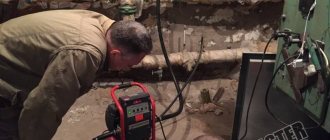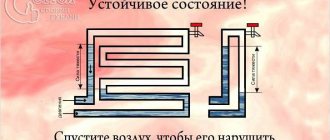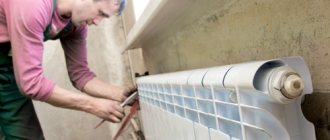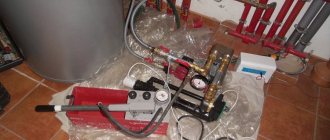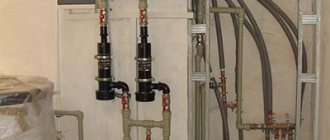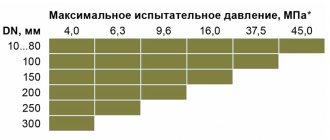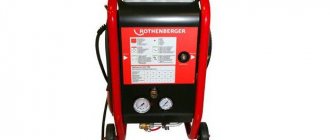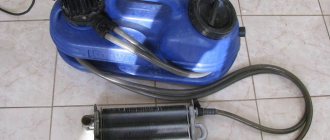What is flushing and pressure testing of a heating system?
Flushing the pipes is necessary for the normal operation of the heating system.
Work to prepare and resume the uninterrupted functioning of the heating guarantees trouble-free flow of the coolant.
Flushing
If the radiators in your apartment begin to heat worse than before, there are several reasons:
- poor boiler performance;
- pump failure;
- airing of pipes.
Over many years of operation, debris, scale particles, and rust accumulate in pipes, heating devices, and collectors. Growing inside, they clog the passage hole for the coolant; the porous structure reduces the heat capacity of the metal parts of the heating devices.
Consequences of blockages:
- burnout of the heat exchanger, requiring its replacement;
- temperature difference in batteries;
- noise in the pump with subsequent failure;
- boiler breakdown.
To eliminate and prevent contamination, washing is performed.
Mineral deposits can completely block the movement of coolant
A decrease in heating efficiency occurs for 2 main reasons:
- The appearance of mineral deposits. Non-galvanized pipes readily accept calcium and magnesium salts on the surface. Such problems do not arise with galvanized pipes.
- Sludge growth in pipe sections with low coolant flow rates. Multi-section cast iron radiators are susceptible to this phenomenon. The dependence is proportional to the increase in volume and number of sections.
People do cleaning of simple appliances and heating pipes in private homes on their own. This is easy to do if you have the knowledge and equipment. It is better to entrust heating systems and radiators in apartment buildings to professionals who are responsible for their work and provide a guarantee.
There are 2 ways to clean the system:
- special hydropneumatic equipment;
- chemical reagents.
The basis of chemical reagents is acid.
Crimping
This procedure is designed to check the hydraulic system for weak points. Tests are carried out using overpressure water circuit or pneumatic method.
Pressure testing of the heating system: flushing, cleaning, procedure, pressure level, photos and videos
Rating: 215
To ensure that the heating equipment is working properly, it is necessary to carry out a test. Such measures are called pressure testing of the heating system with air - a guarantee of reliable operation in winter and maintaining a comfortable temperature in the room.
Indeed, in our latitudes it is impossible to imagine the operation of buildings in winter without heaters. And this applies not only to residential buildings, but also to hospitals, institutions, factories and other buildings. Pipeline pressure testing is a hydraulic test and heating cleaning aimed at finding vulnerable spots.
In what cases is pressure testing carried out?
After installing heaters, as well as replacing a section of pipeline or any individual device, it is necessary to conduct hydraulic studies of the heating system to ensure the tightness of all connections. It is important to remember that pressure testing of the heating system is a guarantee of reliable operation in winter. After all, it’s easier to pressure test the heating system before the cold starts and fix all the problems than to turn off the heating, drain the heating fluid, and carry out repairs in the cold.
How is the tightness of heating equipment pipes checked? To ensure the reliability of the units, air or water enters them under increased pressure. As a result, it is possible to identify places of leaks and integrity violations. Although the load during this process is significantly higher than normal, this cannot damage working mechanisms. Only devices in emergency condition can fail. Pipe leaks can also appear in places where the connections are too worn.
Nowadays, special flushing equipment is used for crimping heating pipes, which allows the entire process to be carried out without involving a large number of workers. For this purpose, compressors and pressure testing pumps are used to clean heating systems.
Manual pressure testing pumps
Work order
Pressure testing of heating is carried out after the end of the heating period and the coolant has been drained from the network. It is important to carefully monitor pressure levels during this process. It will show whether everything is in order or whether there are malfunctions.
Before cleaning the heating system, it is necessary to take into account some characteristics of heating devices. These include the number of floors of the building, the type of wiring and fittings used, the number of risers, as well as the material and structure of the heating pipes.
When checking functionality, there are several main stages. First you need to prepare the system and drain the liquid, then hydraulic tests are carried out with high pressure, and conclusions are drawn, the results are documented. After this, the heating system is flushed and prevented.
Draining liquid
In case of detection of malfunctions, repair and replacement of defective elements is carried out. After this, the entire complex is repeated to ensure high-quality repairs.
Flushing heating equipment
The procedure for flushing heating batteries is prescribed in sanitary norms and regulations (SNiP).
Before carrying out work, it is necessary to flush the pipeline. There are several ways to flush pipes, but its main purpose is to clean the inner surface of the pipes from salt deposits. To do this, a compressor is connected to the heating system. Scale and other deposits contain oxides of the following chemical elements: iron, magnesium, calcium, zinc, copper and sulfur.
Flushing heating equipment
Of course, there is no need to flush the heating pipeline every year, but this procedure must be carried out every 5-7 years. After this, the space for the free flow of coolant increases and the impact on the pipes decreases. This reduces the frequency of breakdowns and makes the operation of heating devices more efficient.
Carrying out hydraulic tests
Hydraulic tests are carried out after washing and examining all chain elements for damage. If such damage is found, it must first be repaired. You should also pay attention to the integrity of the thermal insulation.
When these steps are completed, the pipeline is filled with water and the press is connected, then the pressure gauge data is checked. If the device readings remain constant for half an hour, then no leaks have been detected and the system is completely sealed. A decrease in pressure means that a leak has been detected, it needs to be found and eliminated.
After the completion of crimping, a report is drawn up. And finally, a water hardness sample is taken, the norm is 75-95 units. The completion of these activities confirms the readiness of the devices for the next heating season.
Who carries out the pressure testing
Most often, heating pressure testing is carried out in multi-storey buildings and apartment buildings, as well as in public utilities. To carry out these actions, a specialist must be certified and use equipment designed for these purposes.
Tests of buildings connected to the central heating system are carried out by utility workers. Before carrying out work, it is necessary to bleed out the air; only after this can the pressure test pump be connected.
Test pressure level
To calculate the maximum level of liquid pressure in pipes, you need to have an idea of the operating pressure. If cast iron radiators and pipes are used, then this figure reaches 5 atmospheres. But in private houses it cannot exceed two atmospheres.
Test pressure level
Tests for blowing heating pipes are carried out by increasing the pressure to twice the normal value. When conducting repeated studies, an increase of 20-50 percent is quite sufficient.
Depending on the work that will have to be carried out, an estimate for heating pressure testing is drawn up. To do this, they are guided by a reference book classifying types of activities and products.
It becomes clear that pressure testing of the heating system is a guarantee of reliable operation in winter. Therefore, you should not carry out such important events on your own. This may lead to adverse consequences. For high-quality execution of all stages of the test, it is worth contacting specialists who will not only provide the service in accordance with all standards, but will also bear responsibility and provide warranty service if necessary.
Didn't get an answer to your question? Ask our expert: Ask
sdelatotoplenie.ru
Equipment for work
To clean the pipes, a pump with a hydropneumatic nozzle is required.
In-place flushing of engineering heating systems with chemical reagents is carried out using an eliminator with manual or automatic reverse. There are imported and Russian samples on the market, differing in pumping volume, type of reverse and other functions. The work is carried out using a washing reagent. Then the action of washing with the neutralizing solution is stopped. Electrical devices create excess pressure and force the chemical solution through.
For hydropneumatic cleaning, you need a pneumatic pump capable of reaching a pressure of up to 6 atm. and higher.
A hand pump is a cuvette with a plunger pump located on the side and a drive handle. Shut-off valves cut off water after heating is filled, others are used to drain the coolant from the device. The plunger pump raises the pressure to 60 bar. The disadvantage when used in private homes is that it takes many hours of work and requires a lot of muscular energy.
Professional washers use automatic devices. They set a pressure limit, upon reaching which the automation turns off the unit. Professional models maintain a pressure of 40-100 bar. Industrial pressure testing stations produce up to 1000 atmospheres.
Stages of crimping
The work is carried out at the following frequency:
- when starting a new system;
- annually after the heating season;
- after flushing or repairing the heating main with replacement of pipes.
For apartment buildings, preparation is as follows:
- Inspection of shut-off valves in elevators, central pipes, risers. On cast iron valves, the seals are changed, the paronite gaskets between the connection flanges are renewed, and unusable bolted connections are replaced.
- Using visual observation, pipes and fittings are examined for the presence of cracks, chips, corrosion, and defects. Make repairs if necessary.
- Check the thermal insulation of risers and main pipes in basements.
Pressure testing after pressure cleaning is necessary to identify possible leaks.
Pressure testing procedures and testing are carried out taking into account the parameters of heaters and heating equipment indoors. Regulations allow the use of operating pressures of up to 6 bar for cast iron heating radiators. When they are in the walls, the maximum is 10 bar.
Hydraulic tests are carried out as follows: the system is checked as a whole, then a pressure higher than the working one is applied to the thermal unit.
According to Rules 115 clause 9.2.13., tests are carried out at a pressure not lower than:
- 1 MPa - elevators, heaters for heating and hot water systems;
- 0.6 MPa - cast iron and steel heating radiators;
- 1 MPa - convector, panel heaters;
- working pressure plus 0.5-1 MPa for hot water supply;
- pressure recorded in the manufacturer's instructions for air heaters.
The test pressure in steam systems is selected by the manufacturer from maximum to operating minimum:
- minimum - not lower than 0.2 MPa, but not less than 1.25 working;
- the maximum is established by strength calculations according to standards;
Crimping occurs at temperatures from + 5 degrees. If negative - in emergency cases.
If there is no visible leak, but the pressure drops, the pressure gauge shows problems in hidden places
Crimping stages:
- Filling the system with cold water. During work, the temperature of the liquid is no more than 45 degrees. The pressure increases gradually. Control is carried out using a pressure gauge.
- Once the set pressure is reached, the system remains at rest for about 30 minutes.
- During downtime, an inspection is carried out for leaks in pipes and batteries. Make sure there are no leaks. A method of control is to place toilet paper in dangerous places or wrap pipes with it. When there are leaks, spots of water and silt are visible.
- Control occurs according to the readings of the pressure gauge. The leak occurs in a place inaccessible to observation. A drop in pressure will warn of this.
Upon completion of pressure testing, a certificate of fitness for use is issued.
Tests are carried out by certified companies. In apartment buildings, it is prohibited to carry out heating work yourself. This is done by employees of operating organizations - housing office, management company, housing department, REU. They are required to undergo annual certification at MOEK.
How to do pressure testing of a heating system with your own hands.
To do pressure testing of the heating system yourself, you must initially fill the system with water, maintaining a low filling rate to avoid the appearance of air pockets. Displaced air masses must be vented using shut-off valves. After filling the system, a pressure testing pump is connected to it. This can be an electric or manual pump with a flow rate of about 3 liters per minute.
After reaching the required pressure (up to 2 atmospheres), the system is left alone for 15 - 30 minutes. If the system is sealed, then the set pressure will remain unchanged. In the event of a significant decrease in pressure (by more than 0.01 MPa), it is necessary to check the system for leaks, i.e., inspect the joints, as well as the integrity of individual elements. After the check is completed, the pressure in the system is reduced to working pressure and a pressure test report is drawn up for the heating system.
In general, a pressurized heating system is considered to be a sealed and efficient heating system that has passed a series of tests. Flushing and pressure testing of the heating system is carried out after the end of the heating season and serves as a guarantee that the next season will not have any unpleasant surprises. To control industrial-scale systems, it is better to buy a press for crimping a heating system with an electric drive and a built-in pressure gauge. Manual pumps are suitable for single checks and benefit from lower cost.
Flushing heating systems
The accumulation of silt and scale in pipes and radiators reduces the quality of heating - just 1 mm of scale reduces the heat transfer of the device by 15%. To normalize the temperature in the house, you will have to increase the heat output of the boiler, which means additional fuel and labor costs. Lime is essentially a heat insulator. Its thermal conductivity is 40 times lower than the metal composition. Therefore, even a thin layer leads to a decrease in heat transfer by the coolant. Scale is aggressive. It interacts with the metal and leads to increased corrosion. The aggressiveness of scale creates fistulas and corrodes welds over several years.
In an apartment building
In an apartment building, flushing is done with a chemical solution to remove scale.
The hydropneumatic method of flushing the heating system is constantly used by utility workers. If you follow the technology, this is an effective way.
The principle of operation is simple - first the water is discharged, then it is supplied back to the heating system by pumps. Under the influence of the coolant flow, scale flakes peel off and come out along with the water when drained.
Step by step sequence:
- Before work, all taps are turned off.
- The end caps of the heating batteries are unscrewed using a special key.
- The return valve closes.
- The air pump is connected to the valve located after the valve.
- The return is reset.
- A pressure of over 6 atm is injected into the pneumatics.
- The valve to which the pneumatic equipment is connected opens.
- The risers are blocked one by one. Up to 10 pieces at a time - this will make the washing procedure effective.
The next step is to switch the system to reset in the opposite direction:
- The discharge closes, the valve connected to the device is closed, and the pneumatics are turned off.
- The open valve is retracted, after which a similar one on the return line is opened.
- The water is discharged - the pneumatic pump is connected through the valve in the opposite direction, the valve opens, and the pneumatics turns on. The liquid will flow in the reverse direction.
The productivity of cleaning is determined visually - if clear liquid begins to come out, washing can be completed. The dirt is poured into the prepared dishes. If possible, a hose is connected and the dirty coolant is discharged into the sewer.
In a private house
Rinsing in a private home is necessary if plain water with hard salts is used.
Rinsing in a private home is difficult to do with your own hands, but it can be done by reading the instructions. Produced in two ways:
- Flow method. Cleaning from slag and deposits using this method involves completely filling all devices with coolant while leaving the air vent valve open. After filling, the valve closes. Simultaneously with the supply of compressed air, the drain hole opens. The water-air mixture continues to flow until clean water appears. The amount of flushing liquid is 3-5 times greater than the working value. Therefore, prepare drainage containers or drains in advance.
- Flushing with filling. The system fills with the valves closed. Air is supplied under pressure for a period of 5-10 minutes. into the inlet pipe, while the outlet is closed. After the end of the compressed air supply, the flushing is drained along with dirt and scale.
The volume of supplied liquid and air is calculated individually. An incorrect calculation will lead to numerous pipe breaks rather than flushing.
In private homes, collectors, shut-off valves, boilers, boilers, joints with appliances, electric circulation pumps, and heated floors are checked.
There is no need to buy washing equipment - it is rented. If it is necessary to draw up official papers and a test report, a special team is called. The estimated cost of services is 1000–2600 rubles/hour.
Sample contract for flushing and hydraulic testing of a residential building system
Sample contract These clauses will help avoid conflicts and push the contractor to perform better and more conscientious work.
This clause is called “liability of the parties”. It is also necessary to indicate in the act for flushing the heating system in what cases, in what situation and for what reasons this contract can be terminated. At this stage, the work is just beginning, since before flushing the heating it is necessary to carefully check everything and document both the results of the check and and organizational issues.
The drawn up agreement is signed by the parties. It must be remembered that all controversial issues that arise, unresolved at the level of management of the organization carrying out the work, are resolved in court
To do this, it is extremely important to keep all documents confirming the work carried out by company representatives in your home. To flush heat consumption systems, the following fittings with shut-off valves must be installed on pipelines in heating points of buildings:
- to connect a cold water pipeline, the diameter of the fitting is determined by calculation depending on the capacity of the heat consumption system;
- to connect the compressor, the diameter of the fitting is assumed to be 15 mm;
- to empty the heat consumption system after flushing, the diameter of the fitting is determined by the required time to empty the system and is taken to be at least 25 mm.
- Elevator diaphragms and nozzles must be removed during flushing. After flushing, the heat consumption system must be immediately filled with coolant.
- After flushing, the water supply line for feeding the system must be disconnected. The connection of drainage outlets must be made with a visible gap.
3. Early termination of the Agreement may take place: - by agreement of the Parties - in accordance with clause 7.4. Agreement - on the grounds provided for by the current law on the territory of the Russian Federation9.3.
In the absence of funding, the Customer is obliged to notify the Contractor by telephone message within 3 calendar days.9.4.
Upon termination of the contract, unfinished work is transferred to the Customer in the amount of work completed.
The customer is obliged to pay the cost of the work actually performed.
10. Other conditions.10.1. Damage caused as a result of work to a third party through the fault of the Contractor is compensated by the Contractor, and through the fault of the Customer - by the Customer. In all cases, the Contractor takes urgent measures to eliminate the damage caused, even when the corresponding costs are borne by the Customer.10.2.
